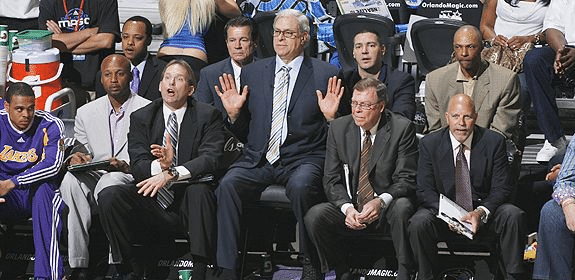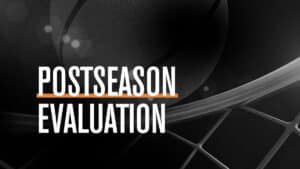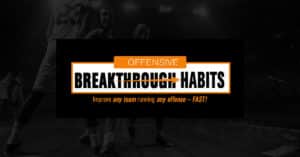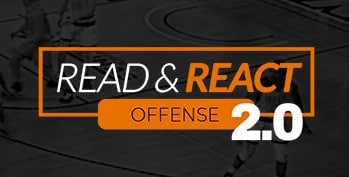One very important thing that I learned through my experience at the University of Florida and being mentored by my good friends at Coaching U is to ALWAYS be prepared and active during games. Too often I get frustrated while watching basketball games on television or in person and I see assistant coaches sitting court-side barking out orders, empty-handed.
The National Basketball Association is the highest level of basketball in the world and is composed of the BEST coaches in the world. One thing I have picked up on in the last couple of years is that you will rarely see an NBA Assistant sitting court-side without a notepad or “book” in their hands. (I call them books because they can become quite thick). They are full of past game notes, scouting reports, play diagrams and play call sheets. Additionally, you will also see them constantly make notes throughout the game on a notepad. So, if the BEST coaches in the world do it, why don’t you? Is it an ego thing? What is it?
If you are sitting empty-handed on the bench, you are unprepared. I understand that most programs have an assistant responsible for that particular scout, so with that said it would make even more sense for the other staff members to “cheat” and have as much information on hand about their opponent as possible.
Head Coaches, you aren’t getting off so easily. You can also be prepared on the bench. Something that Billy Donovan picked up one Summer from Doc Rivers was the creation of a Game Day call sheet. This sheet was folded into three sections so it could easily fit into his pocket and also divided out the different sections. While some of you may think, “Oh, this is the other teams’ top play calls/actions”, that is incorrect! It is a play call sheet that consists of OUR play calls and actions. The Pick & Roll plays were grouped together, SOB and BOB had a section, Early Offense, Motion sets, etc. were all divided amongst themselves. Additionally, there was a section of blank court diagrams in which he would add some ATO (After Time Out) and EOG (End of Game) plays he may draw up throughout the game if needed.
Now you may be asking, well what should I be writing down during games to be an effective assistant on the bench? There is not a perfect answer, it all depends on what your Head Coach wants and thinks will be most useful. Some coaches like to have a shooting chart on the bench to see where shots are coming from, others like to have their assistants keep stats (ie- Rebounds, Assists, TO’s, Blocks, etc.), as well as hustle stats (i.e.- 1st to the floor, charges taken, not blocking out, not crashing the boards, etc.).
My first year at the University of Florida as a manager I was just responsible for getting water/towels to the players and making sure the chairs were out during full timeouts. Needless to say I was oblivious to what the older managers/graduate assistants were responsible for. My 2nd year at the University of Florida, Anthony Grant came up to me 10 minutes before game time and asked if I could keep our defensive efficiency chart. I said yes of course, but let’s be honest, I had no idea what he was talking about. So he handed me this sheet with all these symbols on it. Luckily it was an exhibition game so I could make some mistakes, and I did! I was responsible for knowing what defense we were in and keep track of what happened on EVERY possession. This included transitions and also 2nd shots.
Fast Forward two years and now I was responsible for the offensive efficiency chart. If you know Coach Donovan or watch the Gators play, you know he runs A LOT of plays, A LOT!! Therefore, I had to know every single action in our playbook and be able to pick it out if I did not hear the play call. What a learning experience that was! Like I’ve always said, I was so lucky to get this opportunity!
One of the coolest highlights of this assignment came in a game at Vanderbilt, I was sitting behind the bench and kept seeing how they were guarding our bigs. I mentioned to our Assistant to the Head Coach Darren Hertz that we should run a certain action to counter how they were guarding us. Little did I know he forwarded on that message to Coach Donovan. A few possessions later he called out the play, (INSERT BUTTERFLIES IN STOMACH-I said to myself “What if it doesn’t work?”), well it worked, and we got a dunk! Darren turned around and gave me a fist bump, moments like that are so cool in coaching.
While I will not post the actual Offensive/Defensive Efficiency charts I kept at Florida because I have so much respect for the program I do not want to give away any of their play calls. But what I will do is post the chart that I keep my first season with Fort Myers High School Basketball. It is very similar except in the fact that I now keep both Offense AND Defense, multi-tasking at its finest. I also have a notepad in which I will jot down things I see throughout that I want to remind the coach of or incorporate into practice the next day.
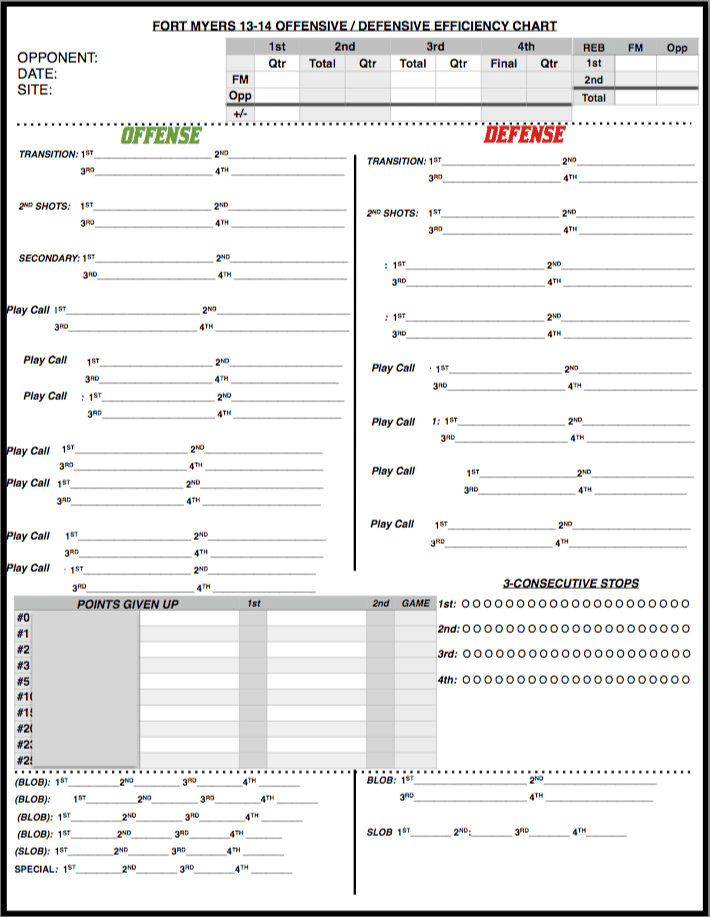
Below is what the sheet looked like after a game (Unfortunately, I wasn’t able to scan one of this year’s final charts):

Here is the KEY of that all of the symbols mean: 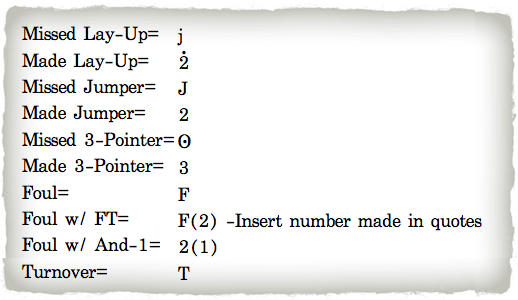
The one thing I love about this Offensive/Defensive Efficiency chart is you can see in real-time what is working and was it not. The ability to know where there points are coming from throughout the game is priceless; at half-time are they hurting us in Transition, 2nd Shots, in the Paint, etc.. What adjustments should we make?
As your season is already deep into conference play and/or post-season, take a step back and ask yourself this question, “Am I doing everything in my ability to be as prepared as I possibly can be during games?”

